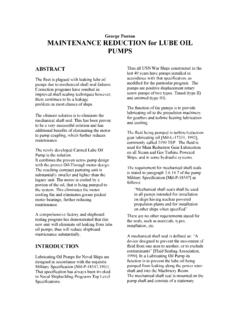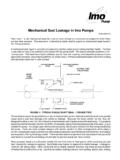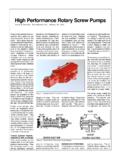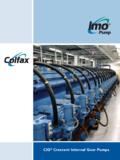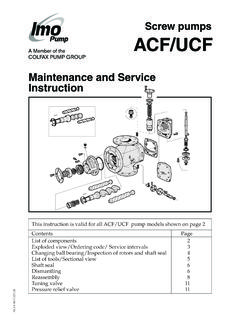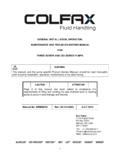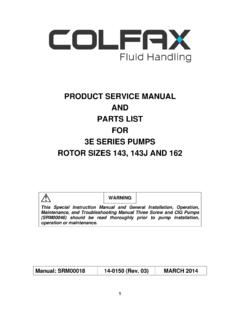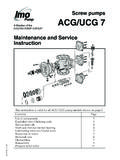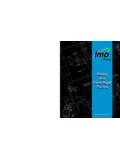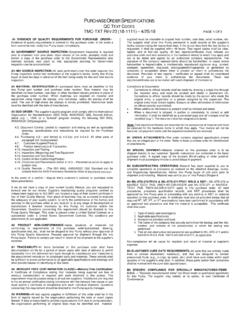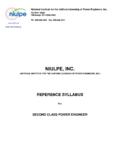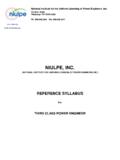Transcription of Combustion Gas Turbine Fuel Pumps
1 James R. Brennan, Imo Industries Inc., Monroe, NC, USAC ombustion Gas Turbine fuel PumpsThe modern Combustion gas tur-bine is one of the most reliablemachines in use and a workhorseof the electric power generatingindustry. They can be on-site andrunning in a relatively short periodproviding quick additional powercapability when needed. The fuelsystem is a very key part of acombustion gas Turbine powerplant or system, figure most common fuels for thesemachines are natural gas and dis-tillate fuel oil. Many industrial ma-chines are delivered suitable toburn either gaseous fuel or liquidfuels. Thus, a liquid fuel system isfrequently a part of the installa-tion. Even if natural gas is theprimary fuel , liquid fuel as a backupis very common to provide forinterruptions in gas fuels are relatively inex-pensive if they are an excess prod-uct from a refinery.
2 Naphtha iscurrently a very popular gas tur-bine fuel in India due to govern-ment regulation. Typical rotarypositive displacement main fuelpump performance is illustrated infigure 2. As can be seen, pumpefficiency is quite good. Flow per-formance is also fairly flat over awide pressure liquid fuels for combus-tion gas turbines include:Many of these fuels require spe-cial treatment and/or handling tobe both safe to use and to mini-mize excessive erosion or corro-sion to the hot gas parts of themachine. For example, naphthais an extremely volatile liquid andsome purchasers of Pumps forthis fuel specify a barrier systemfor the pump shaft seals. Figure 3shows a twin screw naphtha fuelinjection pump that includes a lubeoil barrier system to insure thatNaphthaNatural Gas LiquidsMethanolVarious Jet FuelsKeroseneNatural GasolineCrude OilDistillate (no.)
3 2 fuel )Gas OilResidual (Bunker) fuel OilFLOWDIVISIONTOBURNERSMAIN FUELINJECTIONPUMPFLOWCONTROLVALVEBYPASS RETURNFLOWDIVISIONTOBURNERSFUELTREATMENT SKID IFREQUIREDFUELSTORAGEFROM SOURCE(PIPELINE,BARGE, RAILTANKER, ETC)FORWARDINGPUMPINDUSTRIALSYSTEMAERO DERIVATIVESYSTEMFUELSTORAGECLEANF igure 1 Liquid fuel system schematic9080706050 GPMEFF. %M /H320 cst (100 SSU)20406080100 BARMPa X 1018020022020 cst (100 SSU)504540300600900 PSIKW1200150050100150200250 BHP20 cst (100 SSU)20015010050 Figure 2 Medium size main fuel pumpperformance at 3500 rpm pump speedany shaft seal leakage is lube oilinto the fuel . Such leakage can bereadily detected so that an orderlyshutdown can be initiated to in-vestigate a possible seal 4 is a simplified schematicof the barrier system. The instru-mentation is not shown for TREATMENTSome crude oils and virtually allresidual fuel oils will require heat-ing both to reduce viscosity forefficient handling and to insurethat a maximum viscosity, usuallyless than 20 centistokes (100 SSU), for the burner nozzles isachieved.
4 Low pressure fuel treat-ment skids provide the necessaryfuel conditioning components in apackage ready for site installa-tion. A normal residual oil mayrequire heating in the range of 225to 250 F (107 to 121 C) or fuels will typically requirepretreatment to remove solid con-taminants and may have addi-tives introduced that provide somecorrosion inhibiting performancewhen the fuel is burned. A waterwash to remove objectionablesalts may be needed where watersoluble salts are dissolved in wa-ter and the water is then removed,normally by centrifuge. In addi-tion, gas turbines using crude orresidual fuels are normally startedas well as shut down while burn-ing a light clean fuel , usually distil-late fuel oil. This leaves the injec-tion fuel system, including thepump, flow division mechanismand nozzles, clean for the nextrestart.
5 Otherwise, crude oils orresidual fuel oils may solidify and/or leave deposits that will inhibit asuccessful the main fuel is a heatedfuel and the start up/shut downfuel is unheated, considerationshould be given to the thermalshock that will be imposed on themain fuel injection pump anddownstream fuel system compo-nents when its suction flow isswitched from an ambient tem-perature fuel to one of elevatedtemperature. These Pumps andother fuel system componentstypically have very close internalclearances and drastic or suddentemperature swings should STARTGas turbines are frequently sup-plied in black start configura-tions, that is, equipped to bestarted and brought on-line withno external source of other issues in such aconfiguration is that of supplyingfuel oil at sufficient flow and pres-sure to initiate Turbine combustionmode.
6 This is normally accom-plished by having the fuel injec-tion pump driven from an acces-sory gear (attached pump) that, inturn, is driven by the gas gas Turbine is rotated using adiesel engine, itself a black startconfiguration. The attached mainfuel pump is sized to deliver theminimum light-off flow at maxi-mum light-off pressure at mini-mum light-off speed. Once com-bustion begins, the Turbine is selfsustaining and brought to normalrunning speed with the diesel be-ing clutched out of the accessorygear and stopped. At normal tur-bine speed, the fuel pump willdeliver slightly in excess of themaximum required flow rate dueto being sized for the low speedlight-off RECIRCULATIONNote that it is common practicethat the main fuel injection pumpcontrol valve and bypass reliefvalve flow be returned the inletside of the pump.
7 When burnrates are low and bypass pres-sures are low (no or low load run-ning), there are usually no prob-lems as the power input to thepump is also low. When the pumppower draw is high, such as sub-Figure 3 Twin screw naphtha main gas Turbine fuel pumpstantial to full load on the Turbine ,any bypassed flow will be con-verted to temperature rise withinthe bypassed fuel . Continuoushigh flow bypass to the pump inletcan overheat the fuel resulting inpump damage. This conditioncan exist especially if somethingcauses the main pump relief valveto bypass back to the main pumpinlet such as a failed downstreamflow divider. The preferred by-pass return location is upstreamof the fuel treatment/forwardingpumps or, back to fuel storagetanks if the distance is not exces-sive. In either of these preferredreturn locations, a larger volumeof fuel can dissipate the heat gainbefore the temperature rise be-comes excessive.
8 If the fuel iscontinuously heated as part of itspreparatory treatment, the opti-mum return location is upstreamof the heaters which will reducethe heater load and improve oper-ating efficiency. If recirculation isdirected to the main fuel pumpinlet, then pump liquid suction tem-perature should be instrumentedfor alarm or shutdown if an exces-sive temperature is fuel PUMPSMost power generation gas tur-bines use industrial grade, heavyduty main fuel Pumps , typicallytwin screw or three screw (seefigure 5) designs. Such pumpsare not flight qualified having fartoo low a power to weight derivative gas turbines willsometimes use their equivalentflight qualified main fuel pumpswhich are most ordinarily of thegear pump design. Multistaged,industrial gear Pumps , figure 6,are now also available for use onthese machines.
9 Both the geartype and three screw type pumpswill use 2-pole electric motor di-rect drive speeds of 2900 rpm (50Hz) or 3500 rpm (60 Hz) or 4-pole1450 rpm (50Hz) or 1750 rpm(60Hz). The largest sizes as wellas the twin screw Pumps will use4-pole electric motor speeds. Spe-cific pump configurations will de-pend to varying degrees on thefuel type, operating temperature, fuel viscosity range, required pres-sure rise and flow rate. Main fuelpumps have been supplied forpressures just above 2000 SIZINGR equired pump flow rate will de-pend on a number of variablesincluding Turbine power rating, siteconditions, Turbine thermal effi-ciency, and the heating value ofthe liquid fuel to be used. The netMPUMPCOOLERDUAL FILTERSCONTROLVALVETOSEALFROMSEALLUBE OIL RESERVOIRF igure 4 Simplified fuel pump sealbarrier systemOUTLETINLETINLETOUTLETTIMING GEARSLUBE OIL RESERVOIRTWIN SCREW THREE SCREWF igure 5 Screw pump designs for gas Turbine fuel injectionheating value for distillate fuel is inthe order of 128,000 BTU per gal-lon.
10 At this heating value, a 100%thermally efficient Combustion gasturbine will therefore need per minute ( liters perminute) per megawatt exclusiveof control flow allowances. With athermal efficiency of 30% and acontrol flow allowance of +15%, a100 megawatt machine will needa pump rated to deliver about 170gpm (645 l/m). At a fuel pressurerise across the pump of 1200 psi(83 Bar), a typical requirement,the fuel pump will require a 150 hp(112 Kw) driver and could be ex-pected to operate at around 80%efficiency. For standardized fuelsystem designs, Pumps would besized to provide the required fuelflow for the maximum possibleturbine power rating while pump-ing the lowest net heating valuefuel for which the system is in numbers of main fuelpumps continue to evolve. Themost reliable systems will havetwo 100% capacity main fuelpumps, one acting as standby forthe other.
